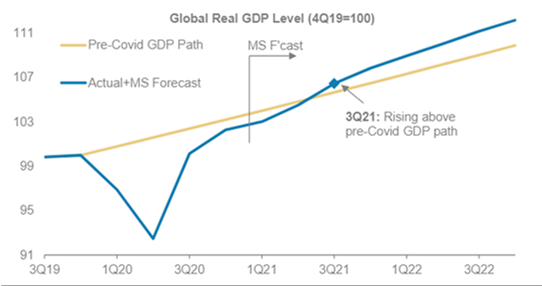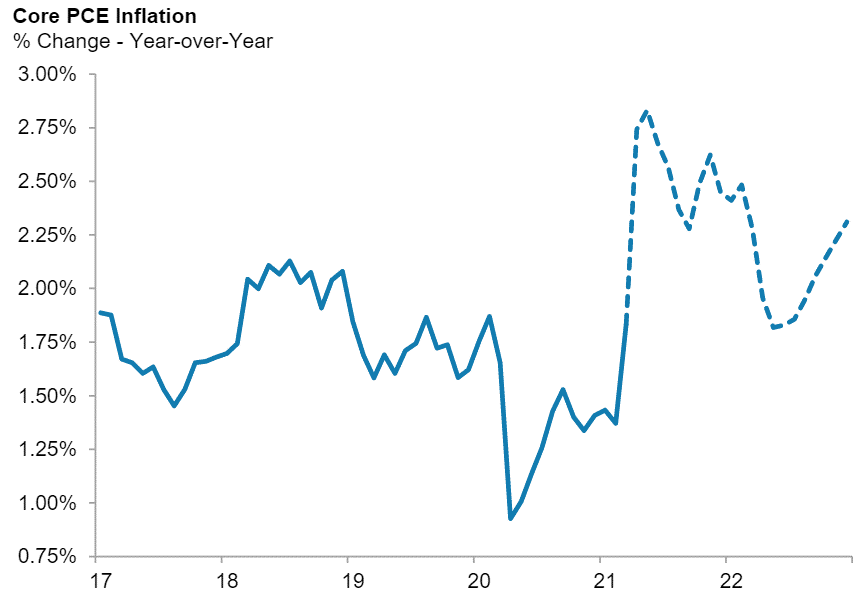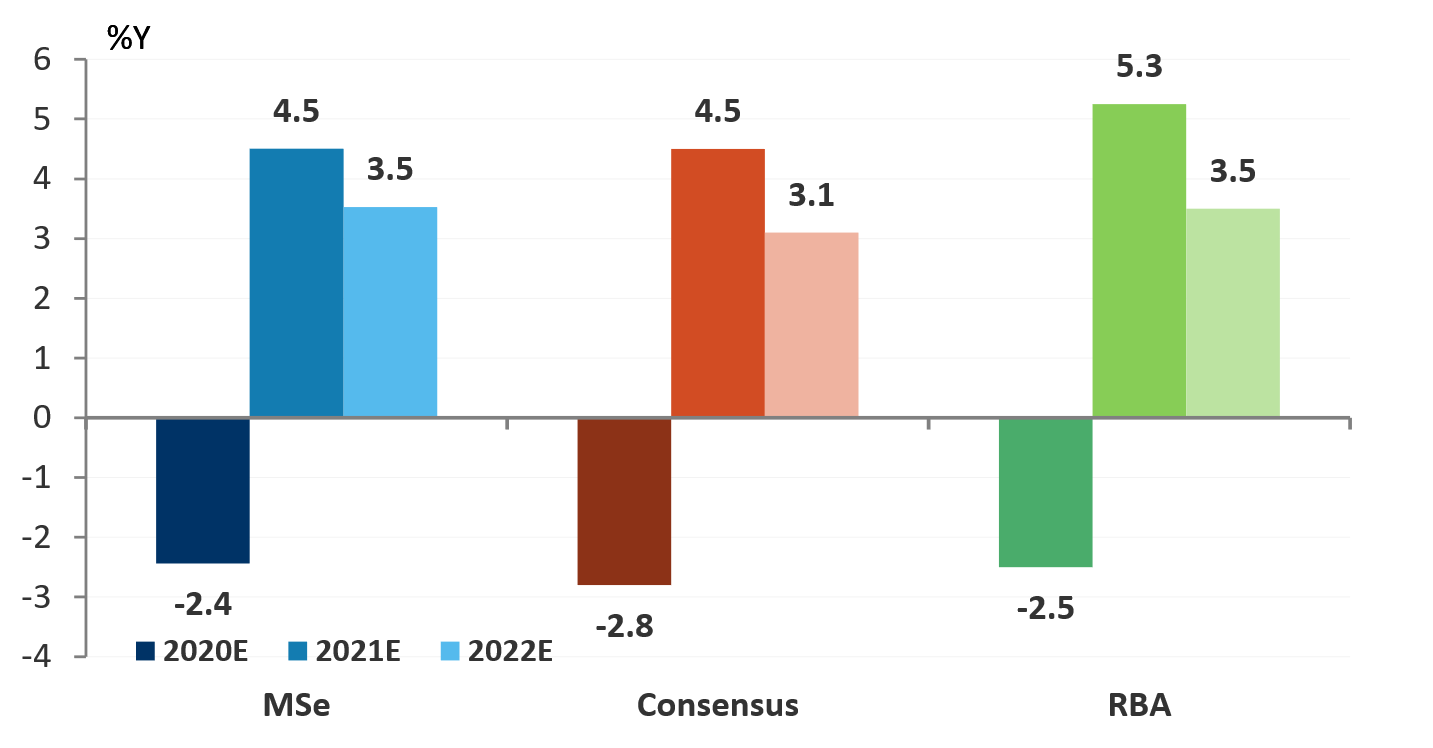Five critical factors for the rest of 2021
Morgan Stanley has just released its mid-year global update. This is an opportunity for our global team of more than 750 analysts, strategists and economists in 21 countries to recalibrate and align our views. This ensures consistency across countries and asset classes regarding our investment outlook.
Five key takeaways have implications for how we position our multi-asset model portfolios:
- A red-hot capital expenditure cycle will drive the next leg of the cycle;
- Policymakers will remain accommodative;
- Inflation is back but manageable;
- Covid-19 vaccination efforts, while uneven, are working; and
- Australia’s economy continues to gain momentum.
We remain positioned for growth in our multi-asset model portfolios but recognise the elevated near-term risk of volatility. We favour the quality and value factors in our equity positions. Interest rates should continue to face upside pressure. Corporate default risk is low, while alternative assets offer protection.
This report draws extensively from the mid-year outlook views published across Morgan Stanley's research department. We acknowledge their collective contribution.
#1 - The red hot capex cycle
The current economic cycle has been supported by government payments to households and businesses through sustaining consumption, which in turn has gained additional momentum as economies reopen. Morgan Stanley believes that we are moving to the mid-cycle of the current economic cycle. Global GDP has already exceeded pre-Covid-19 levels and is on pace to exceed long term trend growth by September. This creates a favourable economic backdrop that we believe will prompt corporations to invest and grow capacity. Morgan Stanley forecasts that global investment will be 121% of pre-Covid-19 levels by the end of 2022 - a level of investment reached 12 quarters from the bottom of the cycle versus 25 quarters after the GFC. We see global GDP growing 6.5% in 2021 followed by 4.8% in 2022, approximately 0.5% higher than consensus for both years.
Exhibit 1 - Global GDP to rise above the pre-COVID-19 path in 3Q21

#2 - Policymakers to remain accommodative
Morgan Stanley expects central banks and governments from major economies to remain highly accommodative. Central banks should only take small steps towards a tightening bias in 2021. For example, we expect the US Federal Reserve to only begin discussing the potential for the end of quantitative easing at its September meeting. The uneven rollout of the Covid-19 vaccine across the world creates enough uncertainty for central banks to retain their loose monetary conditions for fear of impacting the economic recovery. In a similar vein, governments from major economies which have unwritten private sector losses would be reluctant to remove support for a similar reason. Fiscal policy, which is currently at levels unseen outside of war years, should also remain elevated. We also believe that the COVID-19 recession has had a disproportionately more significant impact on lower-income households such that policymakers should err on the side of caution.
#3 - Inflation is rising but manageable
US inflation is currently the primary focus of markets. This is because US inflation impacts the US Federal Reserve's setting for the Federal Funds Rate, which is the key policy rate driving global markets. The US Federal Reserve has an inflation target for Core PCE (Personal Consumption Expenditure) of 2%. Core PCE has not held above 2% since the mid-1990s other than for a few years just prior to the GFC. However, Morgan Stanley believes Core PCE will finally exceed 2% on a sustained basis. Core PCE should peak at 2.7% in the short term, which generally would be a strong sign of overheating. However it is important to note that the Covid-19 recession distorts comparisons versus last year - for example, the price of West Texas Intermediate crude oil fell to -US$37 a barrel at one point. However, after this short period of elevated inflation we are not concerned regarding inflationary pressures per se given higher prices are a natural by-product of a normal economic cycle. That said, Morgan Stanley would reassess this position if Core PCE exceeded 2.5% before June 2022. At this level, we think this could put pressure on the US Federal Reserve to increase the Federal Funds Rate at a faster rate and bring the end of the cycle forward.
Exhibit 2 - Large Swings in Inflation Data Expected

Source: Bureau of Economic Analysis, Morgan Stanley Research
#4 - The vaccination drive is working
COVID-19 vaccination efforts are generally accelerating in Developed Markets but lagging in Emerging Markets. Unfortunately, Australia falls more into the latter group regarding vaccination progress. The evidence so far is the deployment of a variety of vaccines globally are stemming the tide of new infections and allowing economies to open more broadly. The most significant risk to our forecasts is the rise of COVID-19 variants. The slower deployment of vaccines in Emerging Markets might allow more variants to emerge which could become resistant to the current vaccines available. Moderna has shown from early test results that its booster shots are effective against known variants, but this remains far from certain. Our base case assumes no further significant lockdowns at a global level.
#5 - Australia is doing just fine
Morgan Stanley’s local economist and strategist (Chris Read and Chris Nicol) did not make significant changes to their forecasts as they had already incorporated a healthy recovery into their projections. However, they did acknowledge that the slower border reopening will negatively impact growth which saw GDP growth for 2022 revised down to 3.5% from 3.7% - although still keeps it above Morgan Stanley’s long term growth rate. The macroeconomic scenario in Australia is similar to the global narrative, with corporate spending poised to surge (corporate sentiment is at a ~25 year high) and inflation on the rise. Inflationary pressures are not as pronounced here in light of the stronger AUD, which means Morgan Stanley only sees inflation exceeding 2% towards the end of 2022.
Exhibit 3 – GDP Forecasts

Source: Bloomberg, RBA, Morgan Stanley Research
Positioning
What does all this mean for investors?
On a 12 month view, we expect markets to be generally higher. However, at the moment, we observe bear market conditions in the most speculative corners of the market, which historically does not bode well for risk assets. Our Chief US Strategist Mike Wilson believes a 10-20% de-rating in the S&P 500 P/E is entirely plausible, which is a generally conservative stance. In light of this "higher eventually but through a rocky valley" view, we believe the right action currently is to continue rotating within portfolios.
Within Equities, we recommend rotating towards securities with Value and Quality factor characteristics ((Vanguard All-World ex-US Shares Index ETF (ASX: VEU) and VanEck Vectors MSCI World ex Australia Quality ETF (ASX: QUAL). For Fixed Income, we continue to pursue a barbell with an allocation to high quality, long-duration government bonds for protection along with low-duration sub-investment grade credit for income (BetaShares Active Australian Hybrids Fund (ASX: HBRD).
Rising interest rates are still a challenge for Fixed Income securities (in particular government bonds). This is because, on our forecasts, higher-quality securities face negative 12 month total returns as their interest payments are insufficient to offset the capital loss from rising rates. This is the critical challenge facing multi-asset investors - how do you add defensive positions to your portfolio which have positive expected returns. One way is to invest into defensive alternative assets which do not move based on the direction of interest rates but rather position for changes in the internal dynamics of the fixed income market. In our opinion, this is an area where you need an actively managed fund.
Speak to your Morgan Stanley Financial Adviser and ask for direct shares and other ETFs and Managed Funds on our Focus List which align with our positioning views.
4 topics
3 stocks mentioned

